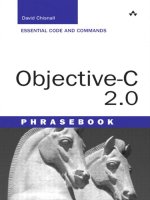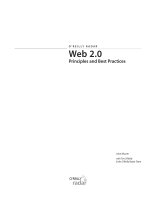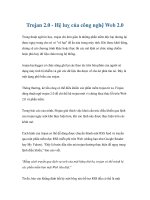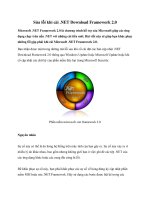Objective-C 2.0 PHRASEBOOK pot
Bạn đang xem bản rút gọn của tài liệu. Xem và tải ngay bản đầy đủ của tài liệu tại đây (3.07 MB, 349 trang )
ptg6519239
ptg6519239
Objective-C
David Chisnall
ESSENTIAL CODE AND COMMANDS
PHRASEBOOK
ptg6519239
Many of the designations used by manufacturers and sellers to distinguish their
products are claimed as trademarks. Where those designations appear in this book,
and the publisher was aware of a trademark claim, the designations have been print-
ed with initial capital letters or in all capitals.
The author and publisher have taken care in the preparation of this book, but make
no expressed or implied warranty of any kind and assume no responsibility for errors
or omissions. No liability is assumed for incidental or consequential damages in
connection with or arising out of the use of the information or programs contained
herein.
The publisher offers excellent discounts on this book when ordered in quantity for
bulk purchases or special sales, which may include electronic versions and/or cus-
tom covers and content particular to your business, training goals, marketing focus,
and branding interests. For more information, please contact:
U.S. Corporate and Government Sales
(800) 382-3419
For sales outside the United States, please contact:
International Sales
Visit us on the Web: informit.com/aw
Library of Congress Cataloging-in-Publication Data is on file.
Copyright © 2011 Pearson Education, Inc.
All rights reserved. Printed in the United States of America. This publication is pro-
tected by copyright, and permission must be obtained from the publisher prior to any
prohibited reproduction, storage in a retrieval system, or transmission in any form or
by any means, electronic, mechanical, photocopying, recording, or likewise. For infor-
mation regarding permissions, write to:
Pearson Education, Inc
Rights and Contracts Department
501 Boylston Street, Suite 900
Boston, MA 02116
Fax (617) 671-3447
ISBN-13: 978-0-321-74362-6
ISBN-10: 0-321-74362-8
Text printed in the United States on recycled paper at RR Donnelly in Crawfordsville,
Indiana.
First printing February 2011
Editor-in-Chief
Mark Taub
Acquisitions Editor
Mark Taber
Development
Editor
Michael Thurston
Managing Editor
Kristy Hart
Project Editor
Anne Goebel
Copy Editor
Bart Reed
Proofreader
Charlotte Kughen
Publishing
Coordinator
Vanessa Evans
Cover Designer
Gary Adair
Compositor
Gloria Schurick
Wow! eBook <WoweBook.Com>
ptg6519239
Table of Contents
Introduction xiv
1 The Objective-C Philosophy 1
Understanding the Object Model 2
A Tale of Two Typ e Systems 4
C Is Objective-C 5
The Language and the Library 7
The History of Objective-C 9
Cross-Platform Support 12
Compiling Objective-C Programs 14
2 An Objective-C Primer 17
Declaring Objective-C Typ es 18
Sending Messages 22
Understanding Selectors 26
Declaring Classes 28
Using Protocols 33
Adding Methods to a Class 35
Using Informal Protocols 38
Synthesizing Methods with
Declared Properties 39
Understanding self, _cmd, super 44
Understanding the isa Pointer 47
Initializing Classes 50
Reading Type Encodings 53
Using Closures 56
Wow! eBook <WoweBook.Com>
ptg6519239
iv
Contents
3 Memory Management 59
Retaining and Releasing 60
Assigning to Instance Variables 61
Avoiding Retain Cycles 63
Autorelease Pools 64
Using Autoreleased Constructors 66
Autoreleasing Objects in Accessors 67
Supporting Automatic
Garbage Collection 68
Interoperating with C 70
Using Weak References 71
Allocating Scanned Memory 73
4 Common Objective-C Patterns 75
Supporting Two-Stage Creation 76
Copying Objects 78
Archiving Objects 80
Creating Designated Initalizers 84
Enforcing the Singleton Pattern 87
Delegation 89
Providing Façades 91
Creating Class Clusters 93
Using Run Loops 96
5 Numbers 99
Storing Numbers in Collections 101
Performing Decimal Arithmetic 105
Wow! eBook <WoweBook.Com>
ptg6519239
Contents
v
Converting Between Strings
and Numbers 108
Reading Numbers from Strings 110
6 Manipulating Strings 113
Creating Constant Strings 114
Comparing Strings 115
Processing a String One
Character at a Time 119
Converting String Encodings 122
Trimming Strings 125
Splitting Strings 126
Copying Strings 128
Creating Strings from Templates 130
Storing Rich Text 133
7 Working with Collections 135
Using Arrays 137
Manipulating Indexes 139
Storing Unordered Groups
of Objects 141
Creating a Dictionary 143
Iterating Over a Collection 145
Finding an Object in a Collection 149
Subclassing Collections 152
8 Dates and Times 157
Finding the Current Date 158
Converting Dates for Display 160
Wow! eBook <WoweBook.Com>
ptg6519239
vi
Contents
Calculating Elapsed Time 163
Parsing Dates from Strings 165
Receiving Timer Events 166
9 Working with Property Lists 169
Storing Collections in
Property Lists 170
Reading Data from
Property Lists 173
Converting Property List Formats 176
Storing User Defaults 178
Storing Arbitrary Objects in
User Defaults 182
10 Interacting with the Environment 185
Getting Environment Variables 186
Parsing Command-Line Arguments 188
Accessing the User’s Locale 190
Supporting Sudden Termination 191
11 Key-Value Coding 195
Accessing Values by Key 196
Ensuring KVC Compliance 197
Understanding Key Paths 201
Observing Keys 203
Ensuring KVO Compliance 205
12 Handling Errors 209
Runtime Differences for Exceptions 210
Wow! eBook <WoweBook.Com>
ptg6519239
Contents
vii
Throwing and Catching Exceptions 214
Using Exception Objects 216
Managing Memory with Exceptions 218
Passing Error Delegates 221
Returning Error Values 222
Using NSError 223
13 Accessing Directories
and Files 227
Reading a File 228
Moving and Copying Files 230
Getting File Attributes 232
Manipulating Paths 234
Determining if a File or
Directory Exists 236
Working with Bundles 238
Finding Files in System Locations 240
14 Threads 245
Creating Threads 246
Controlling Thread Priority 247
Synchronizing Threads 250
Storing Thread-Specific Data 252
Waiting for a Condition 255
15 Blocks and Grand Central 259
Binding Variables to Blocks 260
Managing Memory with Blocks 264
Performing Actions in the Background 267
Wow! eBook <WoweBook.Com>
ptg6519239
viii
Contents
Creating Custom Work Queues 269
16 Notifications 273
Requesting Notifications 274
Sending Notifications 276
Enqueuing Notifications 277
Sending Notifications
Between Applications 278
17 Network Access 283
Wrapping C Sockets 284
Connecting to Servers 286
Sharing Objects Over a Network 289
Finding Network Peers 292
18 Debugging Objective-C 297
Inspecting Objects 298
Recognizing Memory Problems 300
Watching Exceptions 302
Asserting Expectations 304
Logging Debug Messages 306
19 The Objective-C Runtime 309
Sending Messages by Name 310
Finding Classes by Name 312
Testing If an Object
Understands a Method 313
Forwarding Messages 315
Finding Classes 318
Wow! eBook <WoweBook.Com>
ptg6519239
Contents
ix
Inspecting Classes 320
Creating New Classes 322
Index 325
Wow! eBook <WoweBook.Com>
ptg6519239
This page intentionally left blank
Wow! eBook <WoweBook.Com>
ptg6519239
About the Author
David Chisnall is a freelance writer and consultant.
While studying for his PhD, he co-founded the
Étoilé project, which aims to produce an open-
source desktop environment on top of GNUstep,
an open-source implementation of the OpenStep
and Cocoa APIs. He is an active contributor
to GNUstep and is the original author and
maintainer of the GNUstep Objective-C 2
runtime library and the associated compiler
support in the Clang compiler.
After completing his PhD, David hid in academia
for a while, studying the history of programming
languages. He finally escaped when he realized
that there were places off campus with an
equally good view of the sea and without
the requirement to complete quite so much
paperwork. He occasionally returns to collaborate
on projects involving modeling the semantics of
dynamic languages.
David has a great deal of familiarity with
Objective-C, having worked both on projects
using the language and on implementing the
language itself. He has also worked on implementing
other languages, including dialects of Smalltalk
and JavaScript, on top of an Objective-C
runtime, allowing mixing code between all of
these languages without bridging.
When not writing or programming, David enjoys
dancing Argentine Tango and Cuban Salsa,
playing badminton and ultimate frisbee, and
cooking.
Wow! eBook <WoweBook.Com>
ptg6519239
Acknowledgments
When writing a book about Objective-C, the
first person I should thank is Nicolas Roard.
I got my first Mac at around the same time I
started my PhD and planned to use it to write
Java code, not wanting to learn a proprietary
language. When I started my PhD, I found
myself working with Nicolas, who was an
active GNUstep contributor. He convinced
me that Objective-C and Cocoa were not
just for Macs and that they were both worth
learning. He was completely right: Objective-
C is a wonderfully elegant language, and the
accompanying frameworks make development
incredibly easy.
The next person to thank is Fred Kiefer. Fred is
the maintainer of the GNUstep implementation
of the AppKit framework. He did an incredibly
thorough (read: pedantic) technical review of
this book, finding several places where things
were not explained as well as they could have
been. If you enjoy reading this book, then Fred
deserves a lot of the credit.
Finally, I need to thank everyone else who was
involved in bringing this book from my text
editor to your hands, especially Mark Taber who
originally proposed the idea to me.
Wow! eBook <WoweBook.Com>
ptg6519239
We Want to Hear from You
As the reader of this book, you are our most
important critic and commentator. We value
your opinion and want to know what we’re doing
right, what we could do better, what areas you’d
like to see us publish in, and any other words of
wisdom you’re willing to pass our way.
You can email or write me directly to let me
know what you did or didn’t like about this
book—–as well as what we can do to make our
books stronger.
Please note that I cannot help you with technical
problems related to the topic of this book, and
that due to the high volume of mail I receive, I
might not be able to reply to every message.
When you write, please be sure to include this
book’s title and author as well as your name and
phone or email address. I will carefully review
your comments and share them with the author
and editors who worked on the book.
E-mail:
Mail: Mark Taber
Associate Publisher
Addison Wesley Publishing
800 East 96th Street
Indianapolis, IN 46240 USA
Reader Services
Visit our website and register this book at
informit.com/aw for convenient access to any
updates, downloads, or errata that might be
available for this book.
Wow! eBook <WoweBook.Com>
ptg6519239
Introduction
Blaise Pascal once wrote, “I didn’t have time
to write a short letter, so I wrote a long one
instead.” This phrasebook, at under 350 (small)
pages, is the shortest book I’ve written, and
trying to fit everything that I wanted to say into
a volume this short was a challenge.
When Mark Taber originally suggested that I
write an Objective-C Phrasebook, I was not
sure what it would look like. A phrasebook for
a natural language is a list of short idioms that
can be used by people who find themselves in
need of a quick sentence or two. A phrasebook
for a programming language should fulfil a
similar rôle.
This book is not a language reference. Apple
provides a competent reference for the Objective-
C language on the
le.
com site. This is not a detailed tutorial; unlike
my other Objective-C book, Cocoa Programming
Developer’s Handbook, you won’t find complete
programs as code examples. Instead, you’ll find
very short examples of Objective-C idioms,
which hopefully you can employ in a wide range
of places.
One of the most frustrating things in life is
finding that code examples in a book don’t
actually work. There are two sorts of code
listings in this book. Code on a white background
is intended to illustrate a simple point. This
code may depend on some implied context and
Wow! eBook <WoweBook.Com>
ptg6519239
should not be taken as working, usable examples.
The majority of the code you will find in this
book is on a gray background. At the bottom of
each of these examples, you will find the name
of the file that the listing was taken from. You
can download these from the book’s page on
InformIT’s website: />title/0321743628
A Note About Typesetting
This book was written in Vim, using semantic
markup. From here, three different versions
are generated. Two are created using pdflatex.
If you are reading either the printed or PDF
version, then you can see one of these. The only
difference between the two is that the print
version contains crop marks to allow the printer
to trim the pages.
The third version is XHTML, intended for
the ePub edition. This is created using the
EtoileText framework, which first parses the
LaTeX-style markup to a tree structure, then
performs some transformations for handling
cross-references and indexing, and finally
generates XHTML. The code for doing this is
all written in Objective-C.
If you have access to both, you may notice
that the code listings look slightly nicer in the
ePub edition. This is because EtoileText uses
SourceCodeKit, another Étoilé framework, for
Wow! eBook <WoweBook.Com>
ptg6519239
syntax highlighting. This uses part of Clang, a
modern Objective-C compiler, to mark up the
code listings. This means that ranges of the code
are annotated with exactly the same semantic
types that the compiler sees. For example, it can
distinguish between a function call and a macro
instantiation.
You can find all of the code for doing this in the
Étoilé subversion repository: .
org/viewcvs/etoile/trunk/Etoile/
Wow! eBook <WoweBook.Com>
ptg6519239
1
The Objective-C
Philosophy
To understand Objective-C, you need to understand
the philosophy behind its creation. Unlike C++,
D, or Java, which were designed to be new, C-
like languages, Objective-C is a hybrid language.
It is a pure superset of C, meaning that every
valid C program is also a valid Objective-C
program, but it also allows some Smalltalk-like
syntax and semantics.
One of the designers of Objective-C, Tom
Love, described the square bracket syntax as
a signpost reminding you that you were leaving
C and entering “object land.” The original idea
behind Objective-C was a way of packaging C
libraries that encouraged loose coupling between
components.
One of the fundamental design decisions in
Objective-C was that there should be no magic.
All of the details of the implementation are
Wow! eBook <WoweBook.Com>
ptg6519239
2
CHAPTER 1: The Objective-C Philosophy
exposed to the programmer. Unlike C++, where
the details of the vtable are private, Objective-C
lets you inspect and modify everything about
objects and classes.
With older runtime libraries, Objective-C classes
were represented by C structures with a public
definition. You could modify them directly, or
even create new ones and register them with
the runtime system. With newer ones, these
structures are private and there is a set of public
functions for manipulating them as opaque
types.
Understanding the Object Model
Objective-C has a Smalltalk-like object model. If
you come from Java, you will find this very easy
to understand. If you come from a Simula-family
language, such as C++, you may find it a bit
more difficult.
Alan Kay described the idea of objects as a
simple exercise in reduction. When solving a
problem, you want to decompose it into simple
parts. The simplest thing that can run a part
of a program is the same thing that can run
the whole of a program: a computer. Objects,
in Alan Kay’s vision, are simple models of
computers that communicate by exchanging
messages.
This is exactly how objects in Objective-C,
and its parent Smalltalk, behave. They are
Wow! eBook <WoweBook.Com>
ptg6519239
Understanding the Object Model
3
isolated parts of a program that pass messages
between each other. Typically, these messages
are delivered synchronously, so they behave a bit
like a function call, but it’s important to realize
that they are different.
Messages are a higher level of abstraction than
function calls. A function call is very simple.
On many architectures it is a single instruction.
On more RISC-like architectures, you push the
return address onto the stack and then jump. In
all cases, the destination address is fixed.
When you send a message, it is entirely up to
the receiver how to handle it. The most typical
way is to invoke the method with the same name
as the message, but there are other alternatives.
Proxy objects may forward the message to
another object, and they may perform some
substitution on the message arguments before
they do.
Simula did not use the term “object orientation,”
but a lot of Simula-like languages that postdate
Smalltalk have adopted the term, leading to
some confusion. Languages in this family, such
as C++, use virtual function tables (vtables) to
implement something that is superficially similar.
A Simula-style object contains a pointer to its
vtable, or vtables if it has superclasses. When
you call a virtual function, the compiler creates
an offset into the vtable and then a call to the
function at this offset.
One of the side effects of this difference is
Wow! eBook <WoweBook.Com>
ptg6519239
4
CHAPTER 1: The Objective-C Philosophy
that pointer casting in Objective-C and C++
have very different semantics. When you cast
a pointer to one object type to another in
Objective-C, no code is generated. The cast
is just a hint to the compiler’s type checker.
In C++, however, a pointer cast performs
some pointer arithmetic so that code that is
passed the cast pointer can find the vtable at
the correct location. This means that you can
cast any object type to any other object type in
Objective-C, whereas in C++ you need to use a
special kind of cast.
This distinction is very important. In Objective-
C, the only thing that affects the method lookup
is the type of the object. In C++ and other
Simula-family languages, the lookup is also
affected by what the compiler thinks the type of
the object is.
A Tale of Two Type Systems
One of the things that can confuse people
coming to Objective-C is that it has two type
systems. This makes sense if you consider the
original implementation as a preprocessor.
The Objective-C preprocessor would perform
Strongtalk-like
1
type checking and then the C
1
StrongTalk is a dialect of Smalltalk that adds
optional static type checking. The team that created
the language later went to work on Java. It’s worth
noting that, although StrongTalk was one of the fastest
Smalltalk implementations, the compiler did not use
Wow! eBook <WoweBook.Com>
ptg6519239
C Is Objective-C
5
compiler would perform C type checking.
C has a structural type system. Type equivalence
for primitive types is based on whether two types
have the same representation. Complex types are
never regarded as equivalent.
Objective-C adds an algebraic type system. The
type of an object is defined by its signature: the
messages that it claims it will respond to. You
can implicitly cast an Objective-C object to its
superclass, because it is guaranteed to respond
to all of the messages that the superclass
understands.
You can explicitly cast objects to other types.
You could, for example, cast a dictionary object
to an array object. As long as you then only
send it messages that are understood by both
dictionaries and arrays, this will work.
C Is Objective-C
One of the most important features of Objective-
C is that it is a pure superset of C. You can
think of C as a domain-specific language embedded
in Objective-C for low-level tasks and a subset
of Smalltalk as a domain-specific language
embedded in Objective-C for high-level tasks.
There is nothing wrong with solving a problem
using pure C. One of the mistakes that a lot of
people make when learning Objective-C is to
static type information for optimization.
Wow! eBook <WoweBook.Com>
ptg6519239
6
CHAPTER 1: The Objective-C Philosophy
assume that they must stop using C. For a lot
of things, the C solution is the correct one.
Note: Objective-C also has a sister language,
Objective-C++, which has the same relationship
to C++ that Objective-C has to C. Objective-
C++ is a pure superset of C++ and allows you
to call C++ code from Objective-C objects, and
vice versa. Because they have very different object
models, you cannot subclass an Objective-C class
with C++, or the converse; however, you can use
pointers to Objective-C objects as fields in C++
objects and pointers to C++ objects as instance
variables in Objective-C objects.
You can see this in the Cocoa frameworks.
Not everything is an object. If you ask for a
range of characters in a string, you will use an
NSRange structure. This is a C structure—not an
Objective-C object—containing a location and
a length. Points, rectangles, and several other
things are represented in a similar way. If these
were objects, then you would use more memory,
make manipulating them slower, and not really
gain any flexibility.
The Ingalls test
2
for object orientation says
that you should be able to create a new kind
of integer and use this in positioning a window
on the screen. Objective-C fails this test, but
2
Named after Dan Ingalls, one of the designers of
Smalltalk, who proposed it.
Wow! eBook <WoweBook.Com>
ptg6519239
The Language and the Library
7
it’s not a very useful example in the real world,
because most of the time designing new kinds of
integers would break a lot of things that expect
integers to have the standard behavior.
In Objective-C, you don’t have to use the
dynamic behavior, such as late binding and
polymorphism, in cases where it isn’t useful.
The Language and the Library
It’s difficult with very dynamic languages to
draw the line between the language and the
library. In Smalltalk, there is no equivalent of
an if statement in the language. The standard
library defines True and False singleton classes,
which respond to -ifTrue: messages taking a
closure as an argument. All complex flow control
structures, such as loops or enumeration, are
implemented in terms of this.
Objective-C inherits flow control from C, but
all of the dynamic behavior is supplied by the
runtime library. This is different from C or
C++. You can compile a freestanding C or C++
binary that doesn’t call any functions in libc or
libstdc++. Every Objective-C program that isn’t
a pure C program, however, must link against
libobjc to work.
This library traditionally provides three classes:
a simple root class, a class for constant strings,
and a class for protocols. The first of these
provides functionality including object allocation
Wow! eBook <WoweBook.Com>
ptg6519239
8
CHAPTER 1: The Objective-C Philosophy
that is part of the language in C++, Java, and
similar environments. The other two are classes
that may be generated by the compiler.
Most of the time, you will not use any of these
classes. Almost all Objective-C code written in
the last decade or two uses an implementation of
the OpenStep Foundation framework. OpenStep
was a specification jointly worked out by NeXT
and Sun to provide a modern object-oriented
framework for cross-platform application development.
NeXT implemented it on their OPENSTEP
operating system and on Windows NT, whereas
Sun shipped an implementation for Solaris. A
little bit later, the GNU project shipped a third
implementation: GNUstep.
OpenStep defined two frameworks: the Foundation
Kit and Application Kit, typically shortened to
Foundation and AppKit. The Foundation Kit
provides the core functionality that developers
need for all applications, such as collection
classes, run loops, notification delivery, OS
abstraction, and so on. The Application Kit is
built on top of this and provides extra support
for building graphical applications.
Sun’s implementation didn’t see much development
after the initial release. Apple bought NeXT a
few years later and renamed the OpenStep
environment Yellow Box, shipping it as a
developer environment both in Rhapsody and
on Windows. With the release of OS X, it was
renamed yet again, this time to Cocoa.
Wow! eBook <WoweBook.Com>









